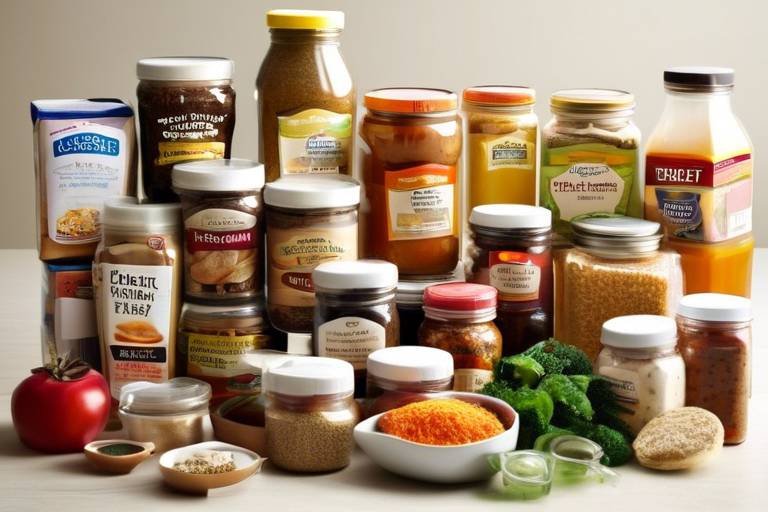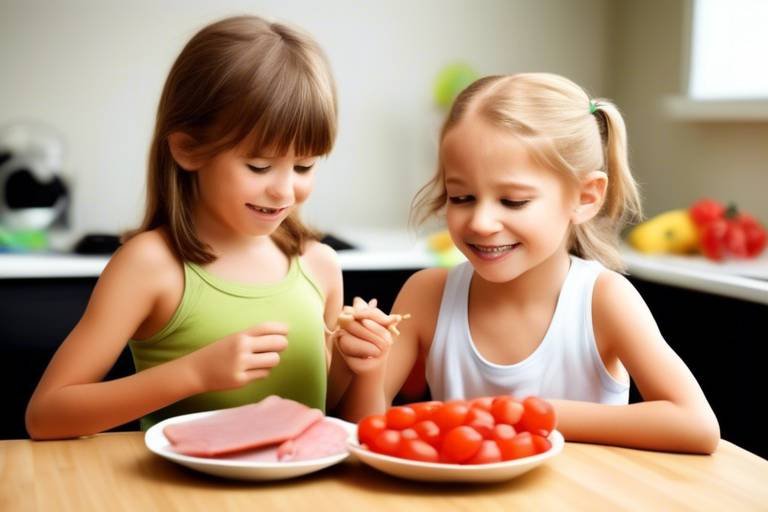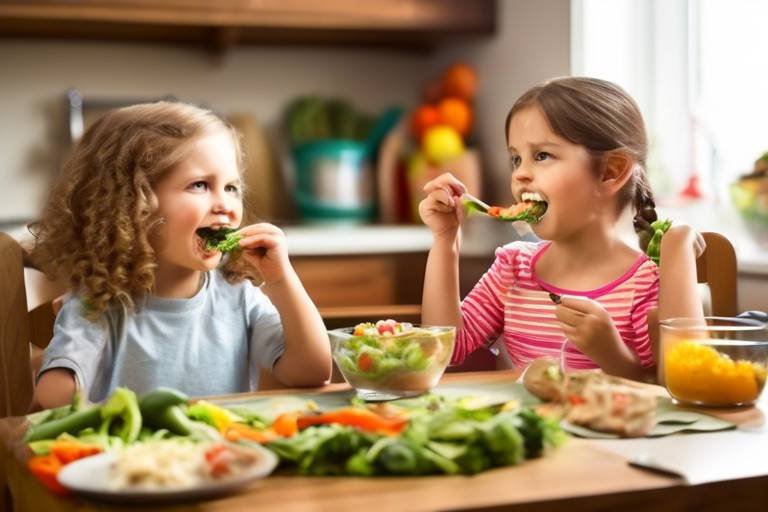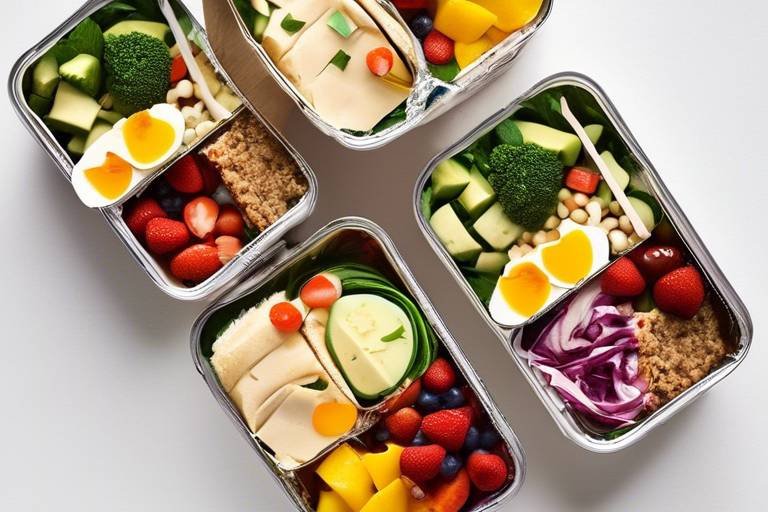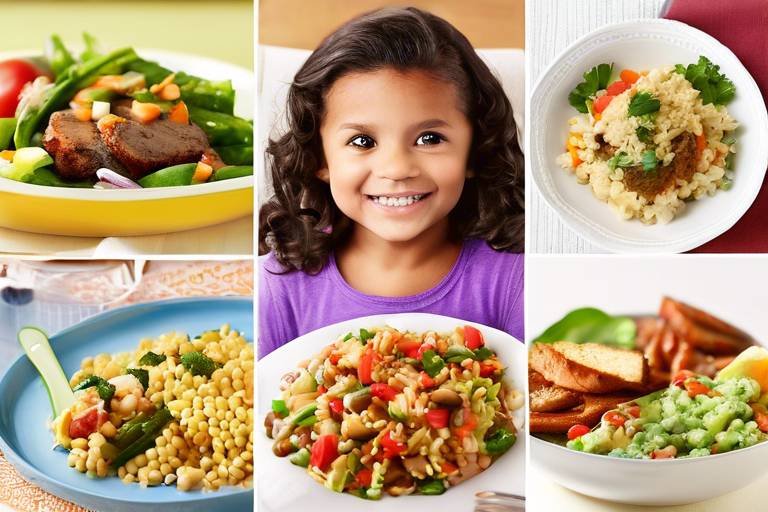Teaching Kids About The Food Pyramid
The journey of teaching kids about the food pyramid is not just about filling their plates with fruits and veggies; it's about igniting a passion for healthy eating that lasts a lifetime. Imagine a world where children make informed food choices, understanding the importance of balance in their diets. The food pyramid serves as a fantastic visual guide, breaking down complex nutritional information into something as simple as a colorful chart. It’s like a roadmap to healthy eating, helping kids navigate their way through the myriad of food options available today.
At its core, the food pyramid categorizes foods into distinct groups, each representing a vital component of a balanced diet. It's structured in a way that emphasizes the importance of consuming a variety of foods, where each layer of the pyramid signifies a different food group. The base is filled with grains, which are essential for energy, while the higher tiers include fruits, vegetables, proteins, and fats. This structure not only teaches kids what to eat but also how to think about their meals in a balanced way. Have you ever thought about how a simple visual can transform a child’s understanding of nutrition?
As parents and educators, we have the incredible opportunity to shape the future of our children’s health. By introducing them to the food pyramid early on, we can instill healthy habits that reduce the risk of obesity and related health issues later in life. It's like planting a seed that grows into a strong tree; the earlier we start, the more robust the foundation. This education doesn’t have to be dull or overly complex. Instead, it can be fun, interactive, and engaging, making the learning process enjoyable for both kids and adults alike.
Engaging children through interactive activities can enhance their understanding of the food pyramid. For example, consider incorporating games and hands-on experiences that make learning about nutrition enjoyable and memorable. Such activities can transform the concept of healthy eating from a chore into an adventure. Kids love to play, and when we can tie in fun with learning, we create a lasting impact. So, how can we make this exciting? Let's dive into some creative methods that can help children grasp these essential concepts.
- What is the food pyramid? The food pyramid is a visual representation of the recommended food groups for a balanced diet, emphasizing the importance of variety and moderation.
- How can I teach my child about the food pyramid? You can teach your child about the food pyramid through interactive activities, cooking together, and using visual aids like charts and posters.
- Why is nutrition education important for children? Nutrition education is crucial for helping children develop healthy eating habits that can prevent obesity and other health issues in the future.

Understanding the Food Pyramid
The food pyramid is more than just a colorful diagram; it’s a vital tool that helps us visualize the components of a balanced diet. Imagine it as a roadmap guiding us to make healthier food choices. At its core, the pyramid is divided into several layers, each representing different food groups that we should include in our daily meals. The base of the pyramid is made up of grains, which should form the largest part of our diet. Think of grains as the fuel for our bodies, providing us with the energy we need to tackle our day-to-day activities.
As we move up the pyramid, we find fruits and vegetables, which are essential for providing vitamins, minerals, and fiber. These foods are like the superheroes of our diet, packed with nutrients that help keep our bodies strong and healthy. The middle layers of the pyramid include proteins and dairy, which are important for building and repairing tissues. Finally, at the top of the pyramid, we have fats and sweets, which should be consumed sparingly. This structure not only helps children understand what foods are important but also how to balance them in their meals.
By grasping the concept of the food pyramid, children can start making informed dietary choices. For instance, when they see that grains should be the foundation of their meals, they might opt for whole grain bread instead of white bread. This knowledge can empower them to choose healthier options, ultimately leading to better health outcomes.
To further enhance their understanding, it’s beneficial to incorporate visual aids like charts and posters that illustrate the food pyramid in a fun and engaging way. These resources can serve as daily reminders of healthy choices and spark conversations at home. For example, you could hang a colorful food pyramid poster in the kitchen and encourage your kids to point out which food group they are including in their meals.
In summary, the food pyramid is a crucial educational tool that helps children comprehend the importance of a balanced diet. By breaking down the different food groups and their roles in our health, we can inspire kids to make smarter food choices that will benefit them throughout their lives. Understanding the food pyramid is like learning to ride a bike; it takes practice, but once they get it, they’ll have the skills to navigate their dietary choices confidently!

Importance of Nutrition Education
Nutrition education is not just a fancy term; it's a vital part of nurturing our children’s health and well-being. Imagine a world where kids grow up understanding the impact of their food choices. This foundation of knowledge can significantly reduce the risk of obesity and other health issues that are alarmingly common in today’s society. By instilling healthy eating habits early on, we’re not just feeding their bodies; we’re also feeding their minds!
Think about it: when children learn about nutrition, they are equipped with the tools to make informed decisions about what they eat. This understanding can lead to lifelong habits that promote better health. By teaching them about the food pyramid, we provide a simple yet effective visual guide that categorizes food groups. This makes it easier for kids to grasp the concept of balanced nutrition. But why stop there? The benefits of nutrition education extend beyond just knowledge. Here are some key points to consider:
- Empowerment: When children understand nutrition, they feel empowered to make healthier choices.
- Prevention: Knowledge helps prevent chronic diseases related to poor dietary habits.
- Confidence: Kids gain confidence in their ability to select and prepare healthy meals.
Moreover, nutrition education fosters a sense of responsibility. Children learn that what they consume affects their energy levels, mood, and overall health. This awareness can lead to a more mindful approach to eating. It’s like giving them a roadmap for their dietary journey, helping them navigate through the abundance of food options available today.
In schools, nutrition education can be incorporated into the curriculum, making it a fun and interactive experience. Imagine kids participating in workshops where they learn to read food labels, understand portion sizes, and even explore the exciting world of cooking! This hands-on approach not only reinforces the concepts of healthy eating but also makes learning enjoyable.
Ultimately, the goal of nutrition education is to create a generation of informed eaters who can make choices that benefit their health. It’s about building a culture where healthy eating is the norm rather than the exception. As parents and educators, we have the power to shape the future of our children’s health through effective nutrition education.
Q1: At what age should children start learning about nutrition?
A1: It's beneficial to introduce nutrition concepts as early as preschool age, gradually increasing complexity as they grow older.
Q2: How can I make nutrition education fun for my kids?
A2: Incorporate games, cooking activities, and interactive lessons that encourage hands-on learning about food and nutrition.
Q3: What resources are available for teaching kids about nutrition?
A3: There are numerous books, websites, and educational programs designed specifically for children to learn about healthy eating.

Interactive Learning Activities
When it comes to teaching kids about the food pyramid, can be a game changer! Imagine a classroom or kitchen buzzing with excitement, where children are not just passive listeners but active participants in their own education. Engaging them through hands-on experiences can turn the sometimes dull topic of nutrition into a fun and memorable adventure. Think of it as a treasure hunt where the prize is a deeper understanding of healthy eating!
One fantastic way to get started is through a Food Group Sorting Game. This activity involves providing children with various food items—real or pictures—and asking them to categorize these foods into their respective groups, such as grains, fruits, vegetables, proteins, and dairy. Not only does this reinforce their understanding of the food pyramid, but it also promotes teamwork and critical thinking skills. Children learn to discuss their choices, defend their categorizations, and even negotiate with peers, making it a rich learning experience.
Another engaging method is to cook together. Inviting kids into the kitchen to prepare meals based on the food pyramid not only teaches them about healthy ingredients but also helps them grasp the concept of portion sizes. Imagine the joy on their faces when they can say, “I made this!” It encourages them to try new foods and understand the importance of including a variety of food groups in their diet. Plus, cooking together fosters a sense of accomplishment and can even spark a lifelong love for healthy eating.
To further enhance the learning experience, utilizing visual aids such as posters and charts can be incredibly beneficial. These resources serve as constant reminders of healthy choices and can spark discussions about nutrition. For instance, hanging a colorful food pyramid poster in the kitchen can prompt daily conversations about what’s on the dinner table. Kids can point to the poster and ask questions, leading to deeper understanding and curiosity about their food choices.
Incorporating these interactive activities not only makes learning about the food pyramid enjoyable but also empowers children to make informed choices about their nutrition. It’s about creating an environment where learning feels like an adventure, and every meal is a chance to explore the wonders of healthy eating!
Q: What age is appropriate for teaching kids about the food pyramid?
A: It's never too early to start! Even preschoolers can begin to understand basic concepts of healthy eating. Tailor the complexity of the information to suit their age.
Q: How can I make learning about the food pyramid fun?
A: Use games, cooking activities, and visual aids to engage children. The more hands-on and interactive the activity, the more likely they are to remember the information!
Q: Are there any online resources for teaching kids about nutrition?
A: Yes! There are numerous websites and apps designed for children that include games, quizzes, and interactive lessons about nutrition and the food pyramid.
Q: How can I encourage my child to try new foods?
A: Involve them in meal planning and cooking. When children have a hand in preparing meals, they are often more willing to try what they’ve helped create!

Food Group Sorting Game
The is not just a fun activity; it's an engaging way to help children understand the different categories of food and their importance in a balanced diet. Imagine a vibrant classroom filled with laughter and excitement as kids dive into the world of nutrition! This game transforms the learning process into an adventure where kids become mini nutritionists, sorting various foods into their respective groups. But how does it work?
To get started, gather a variety of food items or images representing different food groups. You can use real food, pictures, or even toys. The primary categories you should focus on include:
- Fruits
- Vegetables
- Grains
- Protein (meat, beans, nuts)
- Dairy
Once you have your materials ready, divide the children into small teams. Each team will receive a mix of food items or images that they need to sort into the correct food groups. This not only reinforces their knowledge about the food pyramid but also encourages teamwork and communication among peers. As they sort, you can walk around, asking questions to stimulate their thinking, such as, "Why do you think this food belongs in this group?" or "What benefits do we get from eating more of these foods?"
To add an element of competition, you can time each team and see who can sort their items the fastest while still being accurate! At the end of the game, gather everyone together and discuss what they learned. This reflection is crucial, as it helps solidify their understanding and allows them to express their thoughts on healthy eating.
This game is not just about sorting; it's about creating a memorable experience. The excitement of competition, combined with the joy of learning, makes the Food Group Sorting Game a fantastic tool for teaching kids about nutrition. By the end of the activity, children will not only know where different foods belong but also why they are essential for their health, laying the groundwork for lifelong healthy eating habits.
Q: What age group is the Food Group Sorting Game suitable for?
A: This game is suitable for children aged 5 and up, as it can be easily adapted to different age levels by varying the complexity of the food items used.
Q: Can this game be played at home?
A: Absolutely! Parents can easily set up this game at home using everyday food items or pictures from magazines, making it a fun family activity.
Q: How can I make the game more challenging?
A: To increase the difficulty, you can introduce less common foods or ask kids to explain the health benefits of each food as they sort them.

Cooking Together
Cooking together is not just about preparing meals; it's a delightful adventure that can ignite a child's passion for healthy eating! When kids step into the kitchen with their parents, they're not just learning how to mix ingredients; they're also discovering the magic of food and its impact on their bodies. Imagine the excitement on their faces as they chop vegetables or stir a pot of colorful ingredients! This hands-on experience allows children to appreciate the **nutritional value** of what they eat, making the food pyramid come to life right before their eyes.
By involving children in cooking, you can help them understand the importance of each food group. For instance, while preparing a meal, you can explain how grains provide energy, fruits and vegetables are packed with vitamins, and proteins help them grow strong. This interactive learning turns abstract concepts into tangible experiences. You can even create a fun cooking chart together, where you list out the ingredients from each food group that you plan to use in your meals. This not only reinforces their knowledge of the food pyramid but also encourages them to try new foods!
Moreover, cooking together fosters a sense of responsibility in children. They learn about measuring ingredients, following recipes, and even cleaning up afterward. This process can be likened to a mini science experiment, where each step has a purpose and leads to a delicious outcome. To make it even more engaging, you could set up a family cooking challenge where everyone picks a food group and creates a dish that highlights its benefits. This not only promotes teamwork but also makes healthy eating a fun family affair!
In addition to the fun, cooking together can also be a great opportunity to discuss portion sizes and the importance of balance in meals. For example, you could create a colorful plate that reflects the food pyramid, ensuring each food group is represented. This visual representation can help children understand how to create balanced meals on their own in the future.
So, the next time you're in the kitchen, invite your kids to join you. Not only will you be teaching them valuable cooking skills, but you'll also be instilling a love for healthy eating that can last a lifetime. Remember, cooking together is more than just making a meal; it's about creating memories and building a foundation for a healthier lifestyle.
Q: How can I make cooking together more fun for my kids?
A: You can make it fun by turning it into a game! Let them choose a recipe, create a theme for the meal, or even have a cooking contest. The more involved they are, the more they'll enjoy it!
Q: What if my child is a picky eater?
A: Involve them in the cooking process and encourage them to taste new ingredients. Sometimes, kids are more willing to try foods they helped prepare. You can also try to make healthy foods look fun and appealing!
Q: How often should we cook together?
A: Aim for at least once a week. It doesn’t have to be a big meal; even simple snacks can be a great way to bond and teach about nutrition.

Visual Aids and Resources
This article explores the importance of the food pyramid in educating children about balanced nutrition. It provides engaging methods and activities to help kids understand healthy eating habits.
The food pyramid is a visual guide that illustrates the recommended food groups for a balanced diet. Understanding its structure helps children make informed dietary choices and develop healthy eating habits from a young age.
Nutrition education is essential for children to grasp the significance of healthy eating. It lays the foundation for lifelong habits, reducing the risk of obesity and related health issues later in life.
Engaging children through interactive activities can enhance their understanding of the food pyramid. Fun games and hands-on experiences make learning about nutrition enjoyable and memorable for kids.
A sorting game allows children to categorize different foods into their respective groups. This activity reinforces their knowledge of the food pyramid while promoting teamwork and critical thinking skills.
Involving children in cooking can deepen their appreciation for healthy foods. Preparing meals based on the food pyramid encourages them to try new ingredients and understand portion sizes.
Utilizing visual aids, such as posters and charts, can help reinforce the concepts of the food pyramid. These resources serve as constant reminders of healthy choices and can spark discussions about nutrition. For instance, colorful charts depicting the food pyramid can be hung in kitchens or dining areas, making them easily accessible for children. When kids see these visuals regularly, it becomes second nature for them to consider their food choices.
Another effective resource is interactive online tools that allow kids to explore the food pyramid in a fun way. Websites that offer games, quizzes, and videos can captivate their attention while imparting important nutritional information. Incorporating technology into learning can make it more appealing to today’s tech-savvy children.
Additionally, creating a family nutrition journal can be a fantastic way to track meals and snacks while also educating kids about the food pyramid. By logging what they eat, children can visually see how their meals stack up against the recommended servings from each food group. This not only promotes accountability but also encourages them to make healthier choices.
Here’s a simple table that summarizes various visual aids and their benefits:
| Visual Aid | Benefits |
|---|---|
| Posters | Constant reminders of food groups; easy to reference. |
| Interactive Websites | Engaging games and quizzes that make learning fun. |
| Family Nutrition Journal | Tracks food intake; promotes accountability and awareness. |
In conclusion, utilizing visual aids and resources is a powerful way to teach children about the food pyramid. By making nutrition education visual and interactive, we can help kids develop a strong understanding of healthy eating that will last a lifetime.
Parents play a crucial role in modeling healthy eating habits. By incorporating the food pyramid into family meals, children learn to appreciate a variety of foods and the importance of balance in their diets.
Involving kids in meal planning can empower them to make healthier choices. This practice fosters responsibility and encourages them to consider their food selections in relation to the food pyramid.
Parents setting a positive example by eating a balanced diet can significantly influence their children's eating habits. Demonstrating healthy choices reinforces the lessons learned about the food pyramid.
Q: What is the food pyramid?
A: The food pyramid is a visual representation of the different food groups and their recommended proportions for a balanced diet.
Q: How can I teach my child about the food pyramid?
A: You can use visual aids, interactive activities, and involve them in cooking to make learning about the food pyramid fun and engaging.
Q: Why is nutrition education important for children?
A: Nutrition education helps children understand the importance of healthy eating, which can lead to lifelong healthy habits and reduce the risk of obesity.

Healthy Eating Habits at Home
When it comes to teaching kids about healthy eating, the home environment plays a pivotal role. It's where children spend most of their time and where they develop their food preferences. By incorporating the food pyramid into daily family meals, parents can instill a sense of appreciation for a variety of foods. This not only helps children understand the importance of balance in their diets but also encourages them to make healthier choices.
One effective way to cultivate these habits is through meal planning. When families sit down together to plan their weekly meals, kids can learn about different food groups and how to create balanced plates. This practice empowers them to make informed decisions about what they eat. For instance, while planning a meal, you can discuss how many servings of fruits and vegetables should be included, or how to incorporate whole grains. It’s like building a delicious puzzle where each piece represents a food group!
Moreover, when children actively participate in meal preparation, they gain a deeper appreciation for the foods they eat. Cooking together can be a fun and educational experience. Imagine the joy on their faces when they chop colorful veggies or stir a pot of healthy soup! This hands-on experience not only teaches them about nutrition but also helps them understand portion sizes and the importance of fresh ingredients. Plus, it’s a great opportunity to bond as a family, creating lasting memories.
Another key aspect is for parents to set a positive example. Kids are like sponges; they soak up everything they see. If parents regularly enjoy a balanced diet filled with fruits, vegetables, lean proteins, and whole grains, children are more likely to mimic these behaviors. It’s all about leading by example! When children see their parents making healthy choices, they are more inclined to follow suit. This can be as simple as choosing a salad over fries or opting for water instead of sugary drinks.
To further enhance the learning experience, consider creating a family food chart. This chart can visually represent the food pyramid and can be displayed in the kitchen. It serves as a constant reminder of healthy choices and can spark discussions about nutrition at the dinner table. For example, when preparing a meal, you can refer to the chart and ask questions like, “What food group should we add more of today?” This not only reinforces their knowledge but also encourages them to think critically about their food choices.
In summary, fostering healthy eating habits at home is a collaborative effort that involves meal planning, cooking together, setting a positive example, and utilizing visual aids. By actively engaging children in these practices, parents can help them develop a lifelong appreciation for nutritious foods, ultimately leading to healthier lifestyles.
- How can I encourage my child to try new foods? Start by introducing new foods alongside their favorites. Make it fun by involving them in the cooking process and creating a colorful plate.
- What are some quick healthy snacks for kids? Fresh fruit, yogurt, whole-grain crackers with cheese, or veggie sticks with hummus are all great options.
- How often should we discuss healthy eating at home? Regular discussions during meal planning and preparation can reinforce healthy habits. Make it a part of your routine!

Meal Planning Together
Involving kids in meal planning is not just a fun activity; it’s a powerful way to instill a sense of responsibility and awareness about their food choices. When children participate in deciding what goes on the dinner table, they become more invested in their meals and are likely to make healthier choices. Imagine turning a mundane task into a family adventure where everyone gets to express their opinions and preferences! This can transform meal times from a simple necessity into a delightful experience.
Start by gathering the family around the table and discussing the week ahead. Ask questions like, “What do you feel like eating this week?” or “What new recipes should we try?” This opens the floor for creativity and excitement. You can even create a weekly meal planner together, which not only organizes your meals but also helps kids understand the importance of balance as they incorporate various food groups from the food pyramid.
| Day | Meal | Food Groups |
|---|---|---|
| Monday | Grilled Chicken Salad | Protein, Vegetables |
| Tuesday | Vegetable Stir-Fry with Rice | Grains, Vegetables |
| Wednesday | Whole Wheat Pasta with Marinara | Grains, Vegetables |
| Thursday | Fish Tacos with Cabbage Slaw | Protein, Vegetables, Grains |
| Friday | Homemade Pizza with Various Toppings | Grains, Protein, Vegetables |
By creating a meal planner, children can visually see how different meals contribute to their overall nutrition. You might even consider assigning each family member a day to choose the meal, allowing them to take turns showcasing their favorite dishes. This not only makes them feel included but also encourages them to explore a variety of foods, enhancing their understanding of the food pyramid.
Additionally, don’t forget to discuss the importance of portion sizes during your meal planning sessions. Teach them how to recognize when they are full and the significance of listening to their bodies. This knowledge is vital as they grow older and face more food choices on their own. The earlier they learn these skills, the better equipped they’ll be to maintain a balanced diet throughout their lives.
In the end, meal planning is more than just deciding what to eat; it’s about creating a bonding experience that fosters healthy habits. So, roll up your sleeves, gather the family, and enjoy the process of planning meals together. You might find that it’s not just the food that nourishes your bodies, but the time spent together that feeds your souls!
- Why is meal planning important for kids? Meal planning helps children understand nutrition, encourages them to try new foods, and teaches them about portion sizes.
- How can I make meal planning fun for my kids? Involve them in the decision-making process, let them choose recipes, and even assign them specific days to pick meals.
- What if my child is a picky eater? Encourage them to suggest modifications to their favorite meals to include healthier options without overwhelming them.

Setting a Positive Example
When it comes to teaching kids about healthy eating, one of the most powerful tools at our disposal is modeling behavior. Children are like sponges, absorbing everything around them, especially from their parents. If you want your child to embrace a balanced diet, it’s essential to lead by example. This means not just telling them about the food pyramid but actively demonstrating what it looks like in everyday life.
Imagine this: you sit down for dinner, and instead of a plate filled with processed foods, you have a colorful array of fruits, vegetables, whole grains, and lean proteins. Each meal becomes a teaching moment. When kids see you enjoying a variety of foods, they’re more likely to be curious and willing to try them too. It's like planting seeds of healthy habits that can bloom into lifelong choices.
Furthermore, involving your children in the cooking process can significantly enhance their interest in healthy foods. When they help chop vegetables or mix ingredients, they gain a sense of ownership over their meals. This hands-on experience not only makes them more likely to eat what they’ve helped prepare, but it also teaches them valuable skills in the kitchen. You might even find that they start asking for more fruits and veggies simply because they had a hand in making them!
To solidify this positive example, consider the following strategies:
- Be Consistent: Make healthy eating a regular part of your family routine. Consistency helps children understand that these choices are not just occasional but a way of life.
- Discuss Food Choices: Talk about why you choose certain foods over others. Explain the benefits of eating a balanced diet, and how it aligns with the food pyramid.
- Make It Fun: Turn healthy eating into a game. Create challenges like “Try a new fruit this week” or “Create a rainbow plate” to keep things exciting.
Ultimately, remember that your attitude towards food will shape your child's perspective. If you approach healthy eating with enthusiasm, they are likely to mirror that excitement. The journey of teaching your kids about nutrition is not just about the food; it's about creating a positive and engaging environment where they can thrive. So, let’s put on our chef hats and show them how delicious healthy eating can be!
Q: How can I encourage my child to try new foods?
A: Make trying new foods a fun adventure! Involve them in the cooking process, and introduce new ingredients in a playful way. You can also create a “new food night” where everyone tries something different.
Q: What if my child refuses to eat vegetables?
A: It’s common for kids to be picky about vegetables. Start by introducing them in small amounts and pair them with foods they already enjoy. You can also try different cooking methods to find out which ones they prefer.
Q: How can I balance healthy eating with occasional treats?
A: Balance is key! Teach your child that treats can be a part of a healthy diet when enjoyed in moderation. Use the food pyramid as a guide to show them how to fit these treats into their overall eating habits.
Q: Should I involve my child in grocery shopping?
A: Absolutely! Involving your child in grocery shopping can be a great way to teach them about making healthy choices. Let them help select fruits and vegetables, and explain the importance of reading labels.
Frequently Asked Questions
- What is the food pyramid and why is it important for kids?
The food pyramid is a visual representation of the different food groups that make up a balanced diet. It's important for kids because it helps them understand how to make healthy food choices and develop good eating habits from a young age. By learning about the food pyramid, children can reduce the risk of obesity and related health issues later in life.
- How can I teach my kids about the food pyramid?
You can teach your kids about the food pyramid through interactive activities like sorting games, cooking together, and using visual aids such as posters and charts. These engaging methods make learning about nutrition fun and memorable, helping kids grasp the importance of a balanced diet.
- What are some fun activities to help kids learn about nutrition?
Consider organizing a food group sorting game where kids categorize different foods into their respective groups. Additionally, cooking together can deepen their appreciation for healthy foods. Making it a team effort not only teaches them about nutrition but also encourages teamwork and creativity.
- How can parents model healthy eating habits?
Parents can model healthy eating habits by incorporating the food pyramid into family meals and making balanced choices. By setting a positive example and involving kids in meal planning, parents can empower their children to make healthier decisions and understand the importance of variety in their diets.
- What resources are available to help teach kids about the food pyramid?
There are plenty of resources available, including educational websites, nutrition apps, and printable charts. Visual aids like posters can serve as constant reminders of healthy choices and can spark discussions about nutrition in a fun and engaging way.


